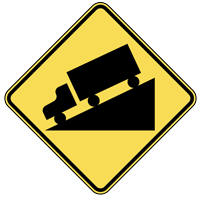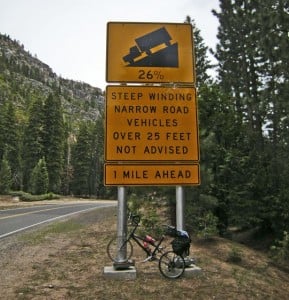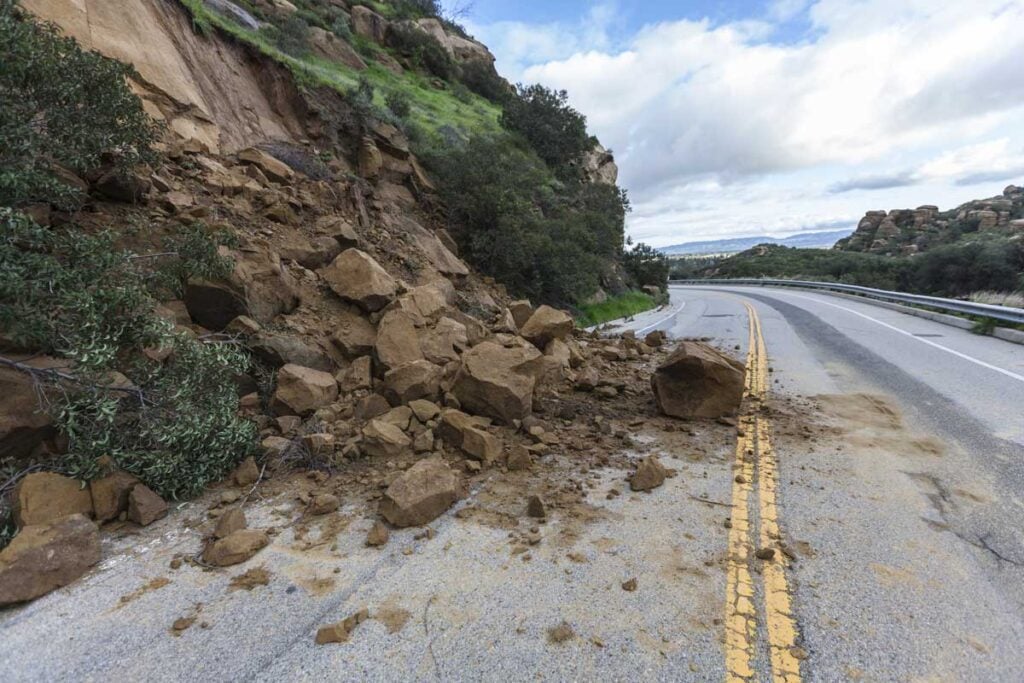A Lug_Nut point of view.
 Extreme mountain grade driving is something most RVers prefer to do in their towed vehicle rather than with their motor home or truck trailer combination. Steep climbs and drop- off downhill grades can turn a pleasant days run into a white knuckle survival experience. So what exactly is considered extreme mountain grades?
Extreme mountain grade driving is something most RVers prefer to do in their towed vehicle rather than with their motor home or truck trailer combination. Steep climbs and drop- off downhill grades can turn a pleasant days run into a white knuckle survival experience. So what exactly is considered extreme mountain grades?
Interstate highways and the majority of state routes are generally limited to 6% to 7% grades. This means for every 100 feet travelled you would climb or descend six or seven feet. A long downhill grade of this descent requires a constant resistance of lower gear operation, Pac Brake, Jake Brake and or service brakes. The heavier the vehicle the harder it is to maintain a reasonable speed. While you can generally use your brakes to check and maintain your speed in your automobile or light truck, the same cannot be said for most RV rigs. Brake friction to slow a heavy rig quickly produces excessive heat that may lead to poor braking efficiency or even full brake failure. While drum type brakes are perhaps more affected by this, disc systems can also overheat and fail.
Extreme mountain grades can be upwards of 18%, well over double what you would normally encounter in the U.S or Canada. These can bring the climb speed of a heavy motor home or trailer combination into single digits on the speedometer at full throttle. Likewise on the descent an extreme resistance will be required to hold back the vehicle. So, heat is a concern when climbing for the engine and transmission, while descending, the brake temperature may be the issue.
Last week I experienced some extreme grade driving while traveling through the Gaspe Peninsula in Quebec, Canada. An extreme steep grade out of Perce took my speed from a start of 30 MPH down to 9 MPH. My coach and tow weighed in at about 52,000 lbs. with a 500 HP Cummins engine. This already gave me slightly less than the 1 HP per 100 lbs. (A standard considered necessary) That was further reduced when the fan drive clutch locked up drawing a whopping 70 HP. leaving me with 430 flywheel HP. I maintained about 9 MPH for most of the climb and gradually picked up speed as I approached the crest and the grade. Descents on these grades were equally challenging. With the Jake Brake in “Hi” I reduced my speed to engage 2nd gear at the outset. Fortunately, the fan drag that worked against me on the up hill climb also automatically engages in the “Hi” mode adding an additional 70 HP braking resistance. Needless to say, the fuel milage crashed to something less than 5 MPG throughout this day. Looking back, I think the up hill climbs were more stressful than the downhill. I hardly needed to engage the service brakes during the descents at any time.
As many seemed interested in this topic last year, I will repeat some of the techniques in the two earlier articles.
So let’s first look at managing steep mountain grades in your RV.
Tips on Managing Your RV’s Speed on Steep Grades:
All Categories of coaches and trailer tow vehicles: When approaching a grade that is descending substantially and will, or may, cause your vehicle to increase speed above that which you wish to travel, or may be safe, do the following. Slow to the speed, or slightly lower, that you intend to descend the sloop, prior to reaching the crest. Be aware of what traffic may be behind you and use caution as you reduce speed as not to cause any danger. Select a lower gear to maximize engine RPM and driveline resistance. Now maintain any excess speed by short adequate hard applications of the service brakes. Remember, the wind resistance is now working with you, and can aid you to keep a comfortable speed.
Medium weight exhaust brake equipped coaches and comparable equipped tow vehicles: Same as the above with the exception of manual selection of a lower gear if your unit is configured to auto-select a lower gear. Engage the exhaust brake (Pac Brake) closest to the selected descent speed as your vehicle crests the hill, and is moving positively down (moving forward without throttle, but in favor of gaining speed). Observe both speed and engine RPM during the descent and control same, if required, with short firm service brake applications.
Tip: Get to know your speed in each gear when the engine RPM is about 90% of the maximum governed loaded speed. If you can’t always remember this speed for each gear, or to just make it easier, put a small red sticker piece at each location on the speedometer. Select your grade descent to be one of these speeds. This will normally deliver smoother braking and possibly eliminate further downshifting. If the engine RPM increases to near that listed in your engine manufacturer’s manual as being the maximum RPM during compression brake application (usually 10 to 15% higher than governed speed), apply the service brakes firmly to bring it back to near its original speed. If, on the other hand, the engine RPM reduces near the speed that would cause an additional downshift, shut off the Pac Brake switch. Do not touch the accelerator pedal if your unit is configured to auto-select a lower gear as that will cause an up shift at this point. You can now toggle the brake switch on and off to maintain the desired road speed during the balance of the decline.
Medium heavy full Jake Brake equipped coaches: Same initial approach as earlier discussed, with the following suggested procedure. Single Jake speed. Follow the same procedure as the Pac Brake. Get to know your speed in each gear when the engine RPM is about 90% of the maximum governed loaded speed. If you can’t always remember this speed for each gear, or to just make it easier, put a small red sticker piece at each location on the speedometer. Select your grade descent to be one of these speeds. This will normally deliver smoother braking and possibly eliminate further downshifting. Two speed Jake. Follow the same procedure as the Pac Brake, except, toggle the “Hi” “Lo” instead of the activation switch.
Tip: This system can provide exceptional downhill speed control. Understanding and utilizing the features that the two speed Jake can provide will give you the full benefits it can deliver.
Heavy coaches, that may be equipped with three speed Jake’s, operate similar to the above mentioned systems. The Jake switch can be multi toggled as required.
Heavy coaches, equipped with transmission grade retarders, should similarly make the same basic grade crest approach. Apply the joystick retarder control at the lowest setting, increasing it as necessary. As many, like the Allison, full grade retarder type transmissions use internal retarders, shift patterns or gear selection may affect the operation.
A word of caution that should be observed in the use of any compression type braking, use only when the road surface provides adequate traction. Even wet roads, particularly just when it first starts to rain, may not be safe for unrestricted use.
 Extreme grades are not always a planned route. Ask other RVers about certain routes as to their challenges. This can be done through forum such as rv.net or irv2.com. Additionally you can talk to fellow RV enthusiasts that you may meet in campgrounds in your travels.
Extreme grades are not always a planned route. Ask other RVers about certain routes as to their challenges. This can be done through forum such as rv.net or irv2.com. Additionally you can talk to fellow RV enthusiasts that you may meet in campgrounds in your travels.
You may encounter extreme grades while traveling in mountainous areas and be faced with this challenge, often without the option of turning around. However, skillful speed management and a cool hand can triumph.
There are of course other hazards that you may encounter in mountainous areas that you must also be aware of. Here are a few.
Road Surface Ice Patches: Temperatures drop as elevation increases at a rate of about 3.56 degrees F. per thousand feet. This is known as the “normal lapse rate”, or temperature to altitude ratio. While this is the usual ratio it can vary. A steeper lapse rate can be experienced when the weather becomes unstable and the ratio may exceed 5 or more degrees F. for every one thousand feet of elevation. Likewise another phenomena is possible where the lapse rate is very low, nil or even a slight increase may be found. This may be an inversion, where warmer air is forced aloft. But never the less, you are far more likely to encounter a normal lapse rate, hence the word “normal”. So, on a 50 F., day driving over a 5,000 ft. mountain pass, freezing temperatures are quite probable. This can result in icy conditions if precipitation is present. But, even on a sunny day ice can form from water running down from the mountains above, particularly in shaded areas.
Wildlife on the Road: While many lower elevation roads present this problem, many mountain roadways have an additional animal, the mountain goat that often wanders on the highway. Rugged terrain can also make the road edge an appealing passage in some circumstances which may result in an increase of roadway wildlife traffic. Combine this with the twisty roads and poor forward roadway view, a shorter warning of wildlife is to be expected.
Rock Fall Warning: While a rock slide is highly unlikely, the possibility of encountering some small rock pieces on the roadway can be very real, particularly after a heavy rain fall. Generally these rock fragments are jagged and can damage or destroy a tire or vehicle. Reducing speed when such warning signs are posted can increase your maneuvering and stopping ability. We have all seen the yellow warning signs, but it is surprising how little attention they are given by most drivers.
Precipitation on an Otherwise Clear Day: When operating at higher altitudes in mountain ranges that are snow capped, precipitation can be encountered even on what looks like a clear day. This can happen when humid air drifts across the snow caps. The frozen ice and snow reduces the air temperature to, or below, the dew point. At this temperature some cloud formation will appear and snow or fine rain may fall.
Reduced Visibility Possible: Quite often the clouds are lower than the mountains are high. If the roadway rises up to, and through, the cloud base, vision may be reduced to near zero. Slow down and observe caution as you would driving in fog.
Shear Road Edges: Unlike most roadways found in the lowlands, mountain roads occasionally have no shoulders or guardrails in some sections. These require special care and attention. Wondering off the road in these areas can have disastrous results.
Engine or Transmission Overheat: Climbing steep grades takes horse power and torque, this causes the drivetrain to heat up. To keep your engine and tranny running cooler, climb grades in a manually selected gear. This then will allow partial throttle climbs without the automatic up-shift. Operating your engine at higher RPM will allow the cooling package to run more efficiently during hard pulls.
Fuel and Services: Generally you don’t see fuel and service stations in the mountains. So, make sure you have ample fuel and that your fluid levels are all topped up.
Affects of High Altitude: Generally there is little affect to most people when exposed to 5,000 feet or so. But there are far higher elevations in the U.S. that you can drive to, about 12,000 feet or more. If you are planning a trip that may take you to these extreme elevations, it would be wise to look into altitude health affects for yourself and those traveling with you. If you plan to camp in the mountains you should be aware of the reduced output that your generator can supply. For each 1,000 feet of elevation above sea level, a 3.5% drop in output will be experienced. So, for example, if you have a 7,000 watt unit, you will only have about 5,500 watts at 6,000 feet or 4,500 watts at 10,000.
Well, those are just some of the challenges you may face when traveling through mountainous regions. The geographic beauty, however, is well worth it. If you have never ventured on these roads in the sky, you may want to give it a try. Just drive safe.
Note: The operation, and or tips, herein stated, may vary or not be applicable to all coach or tow vehicle configurations. Always refer to the directions as outlined in the O.E.M. operator’s manual for your specific coach/rig..
Making The Grade – Lug_Nut – Peter Mercer

It’s interesting to learn that when it comes to driving an RV in a possible rock fall area that there are somethings that we need to be aware of. I am glad that you mentioned that we need to remember to reduce our speed in these areas so that we will be able to maneuver and stop. We are getting ready to take a road trip, and this will help getting us there safely.
I own a 2004 Kountry star class a gas motor home that has a 454hp chev engine in it with a 5speed automatic transmission and when we go up steep hills or mountains it seems to kick into another gear to get us up the hills and we barely make it up and I/m sure there’s a lot of stress on the transmission.What I would like to know is how you should travel up a 10% grade hill and not put tons of pressure on the transmission.
Your 454 hp chev engine is more likely 454 cubic inch displacement. I don’t know any 454 engines that ever produced that hp.
Now, the best less engine/tranny stress climb is accomplished by manually selecting a gear that maintains about an 80% of maximum engine rpm at a partial throttle setting (maybe 3/4 throttle). This, while not over taxing the driveline, keeps the engine coolant circulating at a high rate. Keeping the engine temperature cooler helps to maintain the transmission’s temperature via the tranny’s heat exchanger.
Hey there Peter,I thought the motor in my motorhome was a 454 hp chev engine and found out it is a 490hp chev engine and your right there is a gear in this Allison transmission that kicks in as your going up a hill as we found out going up a 10% grade hill going to Yellowstone park and our transmission broke down on us.We had the tranny replaced and carried onto Vancouver and that’s when I found out you have to gear down going up a 10% mountain.Peter,that was 2yrs. ago and now this year we are having problems with our rebuilt tranny,so good luck with yours and safe travels.
Great post.
Royvia, I’m glad you found the topic of interest. The old advice of “Descend a grade in the same gear as you use to climb it” does not apply unless you run always the same route. Most RV’ers certainly do not.
Thank you for taking the time to comment.
Peter Mercer
Nice post!
Fredro, Thank you for your comment. We can all learn by sharing our experiences.
Peter Mercer